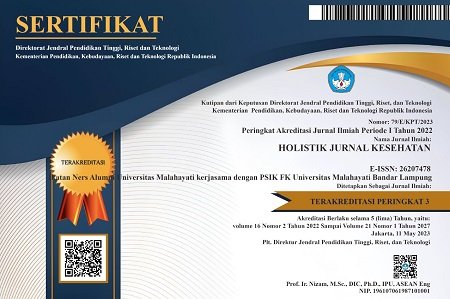Pengembangan program pelatihan edukator tuberkulosis paru
Abstract
Background: The quality of education in patients is a key element in the quality of health promotion in hospitals. The phenomenon that occurs in the pulmonary clinic is the provision of very minimal education and there is no TB educator team.
Purpose: To increase the competence of nurses as educators in the pulmonary clinic by carrying out TB educator training.
Method: The action research, identification of problems with structured interview techniques, observation, and filling out questionnaires to the district head and 2 persons. Analysis of the problem is done with the fish bone method, solving the problem using the planing of action method.
Results: As a condition of completeness of training instruments, curriculum structure and activity descriptions and modules containing training material have been made. From the results of this training a TB educator team will be formed at RS X.
Conclusion: The manifestation of the responsibility of the nursing manager in improving the quality of nursing human resources in order to increase the competence of nurses as tb educators in health promotion and prevention of increasing numbers of patients with pulmonary TB in the hospital by compiling the curriculum structure and basic tb educator training modules.
Keywords: The training; Development; Nursing educators; Management; Pulmonary tuberculosisPendahuluan: Kualitas edukasi pada pasien menjadi elemen kunci mutu promosi kesehatan di rumah sakit. Fenomena yang terjadi di poliklinik paru ialah pemberian edukasi yang sangat minim dan belum ada tim edukator TB.
Tujuan: Untuk meningkatkan kompetensi perawat sebagai edukator di poliklinik paru dengan melaksanakan pelatihan edukator TB.
Metode: Metode yang digunakan dengan penelitian tindakan, identifikasi masalah dengan teknik wawancara terstruktur, observasi, dan pengisian kuesioner kepada kabidyankep dan 2 orang kasie. Analisis masalah dilakukan dengan metode fish bone, pemecahan masalah menggunakan metode planing of action.
Hasil: Sebagai syarat kelengkapan instrumen pelatihan telah dibuat struktur kurikulum dan deskripsi kegiatan serta modul yang berisi materi pelatihan. Dari hasil pelatihan ini akan dibentuk tim edukator TB RS X.
Simpulan: Wujud tanggung jawab manajer keperawatan dalam peningkatan kualitas SDM keperawatan guna meningkatkan kompetensi perawat sebagai edukator TB dalam promosi kesehatan dan pencegahan peningkatan angka penderita TB Paru di rumah sakit yakni dengan menyusun struktur kurikulum dan modul pelatihan edukator TB dasar.
Keywords
References
Ary, D., Jacobs, L. C., Sorensen, C., & Razavieh, A. (2010). Introduction to research in education eight edition. Wadsworth: Cengage Learning.
Baraki, Z., Girmay, F., Kidanu, K., Gerensea, H., Gezehgne, D., & Teklay, H. (2017). A cross sectional study on nursing process implementation and associated factors among nurses working in selected hospitals of Central and Northwest zones, Tigray Region, Ethiopia. BMC nursing, 16(1), 54.
Chesnay, M.D. (2015). Nursing research using grounded theory: qualitative designs and methods in nursing.
Dickinson, A., Welch, C., Ager, L., & Costar, A. (2005). Hospital mealtimes: action research for change?. Proceedings of the Nutrition Society, 64(3), 269-275.
Dyastuti, I. A. (2018). Pengaruh pelatihan kerja terhadap kinerja karyawan ditinjau dari perspektif ekonomi Islam (Studi pada karyawan Deleafing Plantation Group III PT Great Giant Pineapple Lampung Tengah) SKRIPSI (Doctoral dissertation, UIN Raden Intan Lampung).
Gillies, D. A. (1994). Nursing management: A systems approach. WB Saunders Co.
Gunawan, J., Aungsuroch, Y., & Fisher, M. L. (2019). Competence‐based human resource management in nursing: A literature review. In Nursing Forum (Vol. 54, No. 1, pp. 91-101).
Hagos, F., Alemseged, F., Balcha, F., Berhe, S., & Aregay, A. (2014). Application of nursing process and its affecting factors among nurses working in mekelle zone hospitals, Northern Ethiopia. Nursing research and practice, 2014.
Hariyati, R. T. S. (2014). Perencanaan, pengembangan dan utilisasi tenaga keperawatan. Jakarta: PT Raja Grafindo Persada, 109.
International Council of Nurses (2015). TB guidelines for Nurses in the Care and Control of Tuberculosis and Multi-drug Resistant Tuberculosis. 3rd Edition. 1201 Geneva
Langton, N., Robbins, S. P., & Judge, T. A. (2013). Fundamentals of organizational behaviour. Pearson Education Canada.
Manion, J. (2014). Every nurse a leader. Journal of PeriAnesthesia Nursing, 29(4), 320-323.
Marquis, B. L., & Huston, C. J. (2012). Leadership and management tools for the new nurse: A case study approach. Wolters Kluwer Health/Lippincott Williams & Wilkins.
Marquis, B.L. & Huston, C.J. (2017). Leadership roles and management functions in nursing. Sixth edition. Wolter Kluwer Health: Lippincott Williams & Willkins
Muhammad, Y., & Muljono, D. (2014). Action research teori Metode Dan Aplikasi.
Phillips, J. A., & Miltner, R. (2015). Work hazards for an aging nursing workforce. Journal of nursing management, 23(6), 803-812.
Setyawan, F. E. B., & Supriyanto, S. (2019). Manajemen rumah sakit. Zifatama Jawara.
Wicaksono, Y. S. (2016). Pengaruh Pelatihan dan Pengembangan Sumber Daya Manusia dalam Rangka Meningkatkan Semangat Kerja dan Kinerja Karyawan (Studi di SKM Unit V PT. Gudang Garam, Tbk Kediri). Jurnal Bisnis dan Manajemen, 3(1).
DOI: https://doi.org/10.33024/hjk.v14i4.2706
Refbacks
- There are currently no refbacks.
Copyright (c) 2020 Holistik Jurnal Kesehatan

This work is licensed under a Creative Commons Attribution-NonCommercial 4.0 International License.














